Task Force Falcon
Rapid Response to Hurricane Helene Relief Aid in Western North Carolina
By LTC Walter C. Gray II, MAJ Paul Bingham, and CPT Matt Kenny
Article published on: March 1, 2025 in the Spring Issue
of the infantry journal
Read Time:
< 11 mins
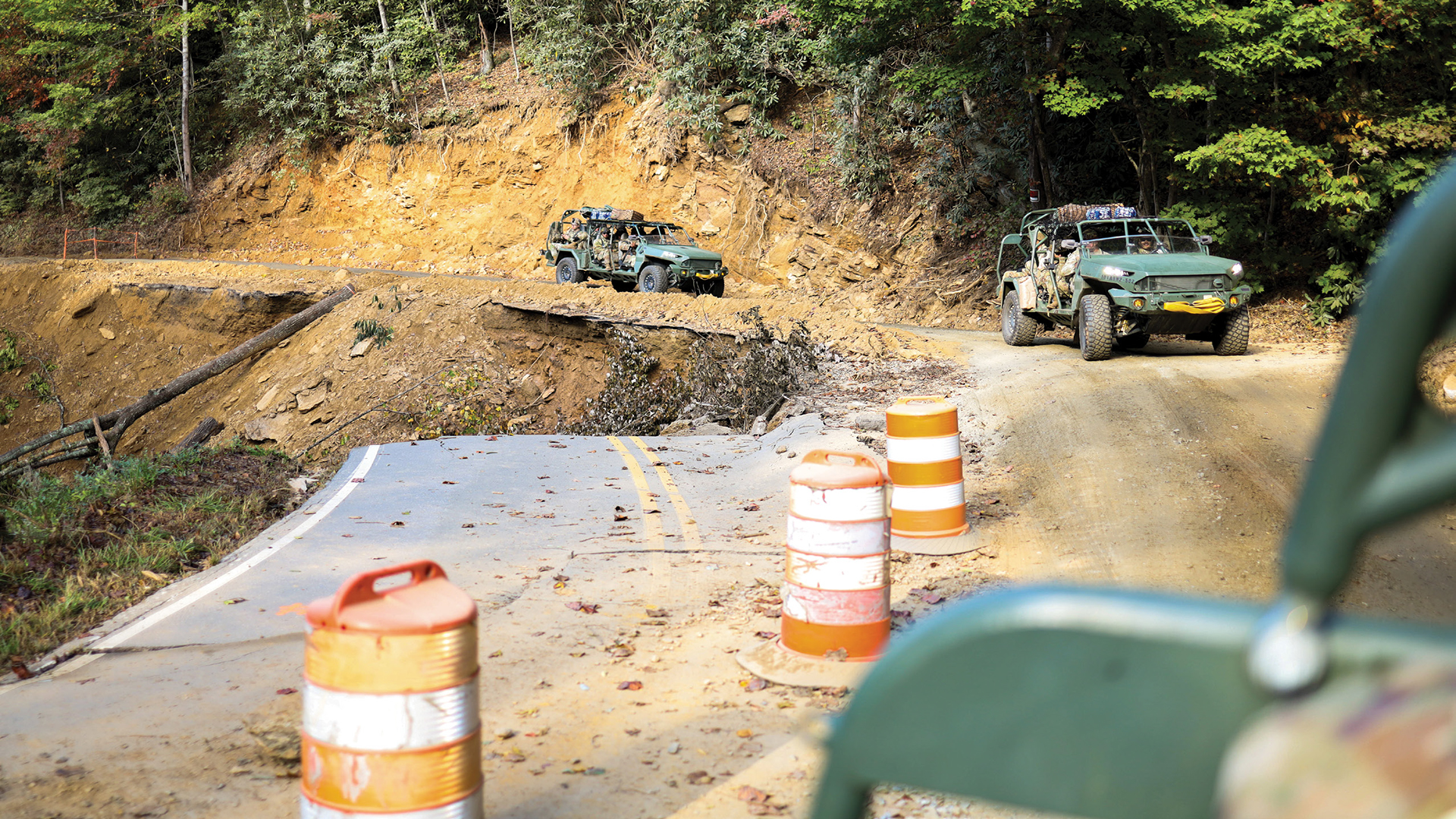
Soldiers assigned to 2nd Battalion, 502nd Infantry Regiment travel to
Garren Creek, NC, to deliver relief supplies on 7 October 2024. (Photo
by SSG Cory Reese)
More than 1,000 Soldiers from the 2nd Mobile Brigade Combat Team (MBCT),
101st Airborne Division (Air Assault) recently deployed to western North
Carolina in support of Hurricane Helene response efforts. 2nd Battalion,
502nd Infantry Regiment “Strike Force” deployed over 500 Soldiers,
forming Task Force (TF) Falcon. TF Falcon conducted a variety of tasks
to include rescue and recovery, medical aid, route assessment clearance,
traffic control, warehouse management, supply distribution, general
transportation, and equipment maintenance. They employed tactics,
techniques, and procedures (TTPs) developed over the past year during
the unit’s transformation from an infantry brigade combat team (IBCT) to
an MBCT. During the operation, TF Falcon leveraged lessons learned and
best practices developed during multiple repetitions of large-scale,
long-range air assault (L2A2) operations at home station and the Joint
Rotational Training Center (JRTC). This article provides reflections
about TF Falcon’s Hurricane Helene response, the capabilities of an MBCT
in a civil support mission set, and lessons learned that may be
applicable to future L2A2 operations.
Timeline and Mission
The 101st Airborne Division issued a verbal warning order to 2-502 IN on
3 October to be prepared to send up to a battalion task force to support
relief efforts following Hurricane Helene. Within 36 hours of
notification, Strike Force assembled and organized TF Falcon, and within
15 hours of notification of modes of travel, it deployed more than 500
Soldiers to support humanitarian operations in western North Carolina.
2/101 MBCT attached its Multi- Functional Reconnaissance Company (MFRC)
and Havoc Company (Forward Support Company), 526th Light Support
Battalion (LSB) to provide capability and endurance.

Soldiers from 2nd Battalion, 502nd Infantry Regiment begin staging for
hurricane response efforts. (Photo courtesy of the 101st Airborne
Division Public Affairs Office)
TF Falcon deployed on 5 October by both ground and air, using 11 CH-47
and five UH-60 helicopters, five ground convoy serials, and six coach
buses to insert into the joint operational area (JOA) and occupy the
intermediate staging base (ISB). Fifty-nine Soldiers traveled by
contracted buses that morning to Greenville, TN, to establish ISB
Greenville while one CH-47 simultaneously initiated air movement to
deliver the TF commander and the assault command post to Helicopter
Landing Zone (HLZ) Castle in Marion, NC, in order to link up with the
higher headquarters commander of the 20th Engineer Brigade.
Two-hundred-eighty-one Soldiers began ground movement with 67 Infantry
Squad Vehicles (ISVs) and 31 additional tactical support vehicles at
0830 on 5 October. After this initial movement, TF Falcon delivered 248
Soldiers and 18 ISVs into the JOA. On 6 October, it continued to deliver
forces to the JOA and increased its presence to 370 Soldiers, 34 ISVs,
and three field litter ambulances (FLAs). TF Falcon also established a
separate primary HLZ at Camp Windy Gap in Weaverville, NC, to deliver
forces one hour closer to the point of need. The final air movements
from the ISB to the JOA concluded on 7 October, resulting in the arrival
of all TF Falcon Soldiers and equipment in the JOA in less than 72
hours.

Figure 1 — 2-502nd Task Organization
| Mission Assignment Task Order |
| TF Falcon Hurricane Response |
| CAO: 12 1100 OCT 24 |
| 7.4 |
FRAGO 8 to OPORD 25-001 |
06 0700 OCT 24 |
42 CEC-I |
14 1700 OCT 24 |
LTC William Hathaway |
Establish truck restriction barriers on NCDOT routes to prevent
tractor usage
|
BUNCOMBE COUNTY |
| 7.4.1 |
FRAGO 8 to OPORD 25-001 |
06 0700 OCT 24 |
42 CEC-I |
14 1700 OCT 24 |
LTC William Hathaway |
Set tractor barrier |
Cove Creek Rd at US 276 |
| 7.4.2 |
FRAGO 8 to OPORD 25-001 |
06 0700 OCT 24 |
42 CEC-I |
14 1700 OCT 24 |
LTC William Hathaway |
Set tractor barrier |
I-26 Westbound at Exit 3 |
| 7.4.3 |
FRAGO 8 to OPORD 25-001 |
06 0700 OCT 24 |
42 CEC-I |
14 1700 OCT 24 |
LTC William Hathaway |
Set tractor barrier |
NC209 at I-40 and Exit 24 |
| 7.4.4 |
FRAGO 8 to OPORD 25-001 |
06 0700 OCT 24 |
42 CEC-I |
14 1700 OCT 24 |
LTC William Hathaway |
Set tractor barrier |
US 70/25 |
| 7.4.5 |
FRAGO 8 to OPORD 25-001 |
06 0700 OCT 24 |
42 CEC-I |
14 1700 OCT 24 |
LTC William Hathaway |
Set tractor barrier |
US 197 at US 19E |
| 7.9 |
FRAGO 8 to OPORD 25-001 |
06 0700 OCT 24 |
RENEGADE CO |
14 1700 OCT 24 |
Mr. Travis Donaldson |
Conduct emergency route clearance, local lifesaving assistance to
isolated homes, and general manpower support
|
HAYWOOD COUNTY |
| 7.9.1 |
FRAGO 9 to OPORD 25-001 |
06 2100 OCT 24 |
RENEGADE CO |
14 1700 OCT 24 |
Mr. Travis Donaldson |
Wayfinding to households on Temple Rd and Blue Ridge Assembly Rd
(primary bridge washed out)
|
Black Mountain, NC |
| 7.9.2 |
FRAGO 9 to OPORD 25-001 |
06 2100 OCT 24 |
RENEGADE CO |
14 1700 OCT 24 |
Mr. Travis Donaldson |
Debris clearance and route widening (beyond quad width to vehicle
width) to Summer Haven community
|
Summer Haven Rd, Swannanoa, NC |
| 7.9.3 |
FRAGO 9 to OPORD 25-001 |
06 2100 OCT 24 |
RENEGADE CO |
14 1700 OCT 24 |
Mr. Travis Donaldson |
Side roads and neighborhoods east of Merrimon Ave between Williams
St. and Stoney Knob Rd, including Reems Creek Rd east to Paint
Fork Rd.
|
Weaverville, NC |
Figure 2 — Task Force Falcon Mission Assignment Task Order
Task Organization
Of the 537 Soldiers assigned to TF Falcon, 345 were organic to 2-502 IN:
96 Soldiers from Attack Company (A Co.), 80 from Renegade Company (B
Co.), and 107 from Charger Company (C Co.). Two scout squads from the
Strike Force Multi-Purpose Company (MPC) were assigned to both Attack
and Charger Companies. 2/101 MBCT delegated operational control of 81
Soldiers from the brigade MFRC to TF Falcon as well as 78 Soldiers from
the 42nd Combat Engineer Company-Infantry (CEC-I). TF Falcon maintained
internal sustainment support capabilities through H/526 LSB (TF Havoc),
with 51 Soldiers attached.
TF Falcon and TF Talon (1st Battalion, 502nd Infantry Regiment, 2/101
MBCT) fell under the higher headquarters of the 20th Engineer Brigade
and the XVIII Airborne Corps to create TF Castle. While TF Castle held
operational control, both task forces operated in conjunction and within
parameters set forth by the state of North Carolina through mission
assignment task orders (MATOs). These MATOs directed TF Falcon on areas
requiring support and assistance, typically counties or major public
road infrastructures. Additionally, these MATOs detailed authorized
methods of support by Title 10 forces within the JOA, including route
clearance, aid distribution, obstacle removal, traffic control, and
general incident assessments. These MATOs served as parameters for TF
Falcon leaders to ensure lines of effort in providing aid enabled
immediate response to hurricane effects and set conditions for recovery
within the JOA.
Air Movement Planning for Civil Support Response
After conducting L2A2 training exercises at home station (April 2024)
and to JRTC (January and August 2024), the 101st Airborne Division
determined the number days required to effectively plan and execute an
L2A2. Based on mission requirements and the immediate activation of
Title 10 forces, TF Falcon began air movement 15 hours from notification
that the task force would move by air. The division quickly executed the
air assault planning process within the allotted time and developed a
course of action that included air movements over three days to deliver
all passengers and vehicles. HLZ Castle served as the primary HLZ for
day one while HLZ Nighthawk at Camp Windy Gap became the primary HLZ for
days two and three. The L2A2 training conducted over the past year and
the relationships built between the ground force and the Combat Aviation
Brigade (CAB) were invaluable to the success of this operation.
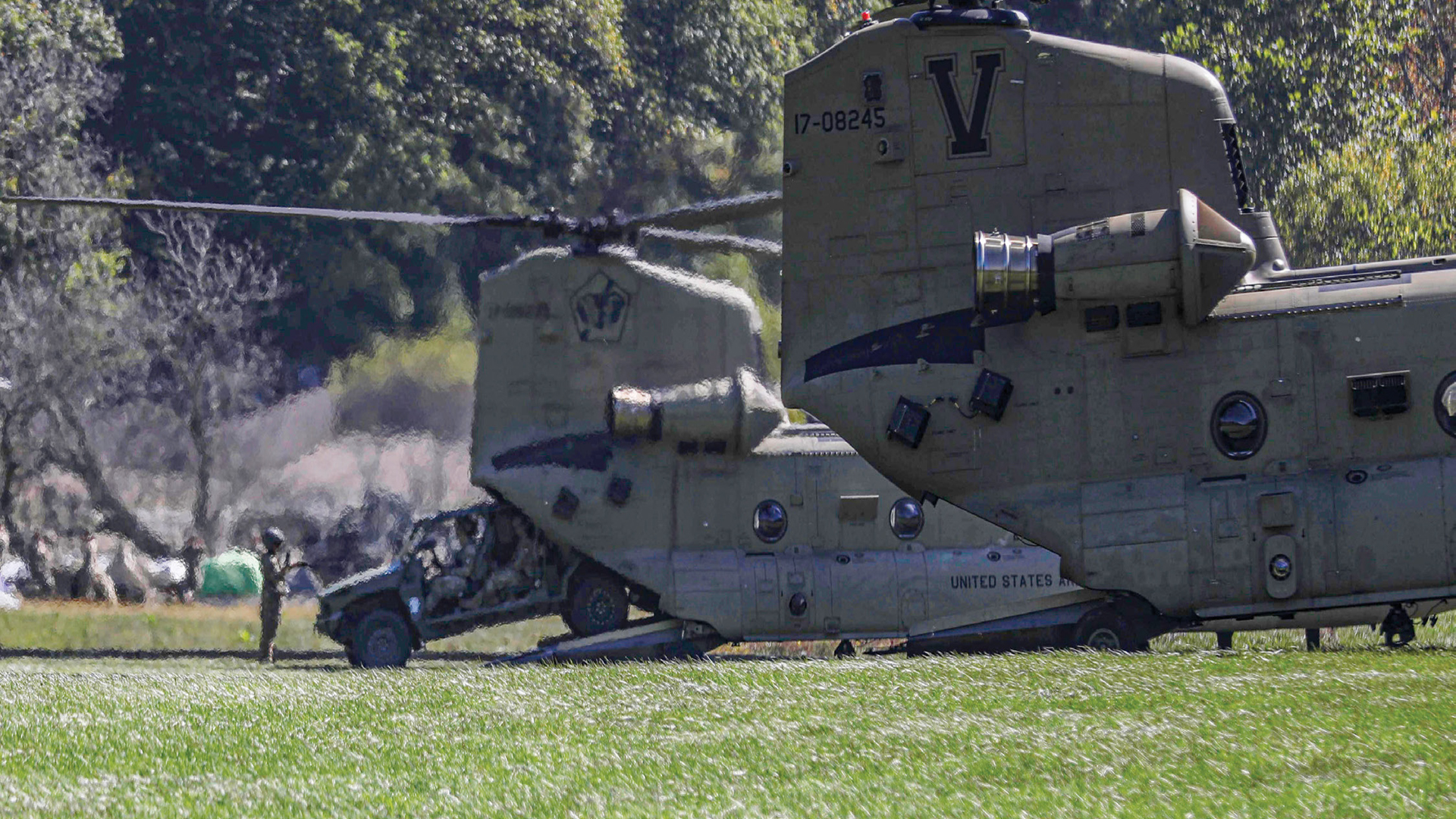
Soldiers offload Infantry Squad Vehicles at the start of hurricane
relief efforts. (Photo courtesy of the 101st Airborne Division Public
Affairs Office)
Civil Partner Integration
TF Falcon quickly realized that the most efficient way to understand the
operational area and environment was to integrate into the local
populace. We quickly built relationships with local fire departments and
non-governmental organizations (NGOs) to understand the ground truth,
aid individuals, and identify points of need. Quickly understanding what
the people needed and delivering on those needs opened opportunities for
support and as well as built relationships with the local leaders and
population.
Situational understanding of the critical need, as time went on, we
began to recognize that local leadership and NGOs were often inundated
with information. Crisis management teams (CMTs) from around the country
were utilized to relieve the burden of local first responders to meet
the critical needs on a large scale, and many NGOs worked to meet direct
needs of the populace on a smaller scale. Our team eventually became the
connective tissue between many organizations that were working very hard
within the scope of their problem set but did not effectively work with
other organizations. This led to duplicated and wasted effort and
resources on numerous occasions.
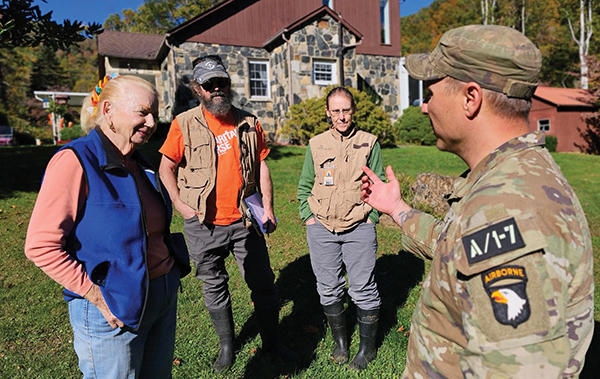
A Soldier from the 2nd Mobile Brigade Combat Team, 101st Airborne
Division meets with civilians during hurricane relief operations.
(Photo courtesy of the 101st Airborne Division Public Affairs Office)
To prevent this, our companies conducted a daily sync with the county
emergency operations centers (EOC) in the morning. Following this sync,
one company would go to every distribution center throughout the county
and every location their platoons were working at as well as the fire
departments/ police stations in each town within the assigned county.
This served multiple purposes as each day brought new information.
First, taking about 20-30 minutes at each site allowed us to have the
most up-to-date information for each location throughout the county. We
were able to discuss the needs of each region of the county and visibly
see the affected areas and their progress while making valid
assessments. Second, more than just a phone call, we could discuss the
information being consolidated at the EOC and confirm with our platoon
leadership.
Each night the companies debriefed their platoons and ensured that they
were hunting for information while out conducting missions. The platoon
leaders and platoon sergeants were by far the most valuable sources of
information. They spoke with distribution center leaders, church
leadership, and every civilian they came across to assess needs
throughout the day. Each day our company leadership brought this
information to the EOCs to ensure they understood the updated needs of
the county and were not reliant on stale information. We acted as the
hands, feet, and eyes of the county EOC and provided timely and accurate
reporting to paint the bigger picture for them.
Additionally, our partnership with the National Guard was critical. One
company remained overnight near the National Guard regional command
team, and each day the company’s leaders met with leadership at the
central receiving and distribution point (CRDP) to assess the needs of
the distribution centers scattered throughout the county. We then
brought this information to the National Guard liaison officer at the
EOC to ensure that distribution of resources was being properly managed.
Service Support and Sustainment
As TF Falcon massed forces within the JOA, the next problem set was
long-term sustainment within the area. Operating off the assumption that
logistical support would be minimal on ground, elements from the 526th
LSB were consolidated under Havoc Company to provide logistical support
for both TF Falcon and TF Talon. The two biggest capabilities that Havoc
brought to the operation were wreckers and bulk resupply assets. Despite
their necessity in the operation, bulk resupply assets created
significant strain on convoys attempting to move through the mountains
to reach Logistics Support Area (LSA) Marion.
By rapidly establishing multiple LSAs, TF Falcon could conduct
decentralized operations throughout the JOA, giving commanders the
freedom to operate from whichever location was closest to the
communities specified in their MATOs.
Consequently, Havoc became delayed several times in their ground
movement due to their Heavy Expanded Mobility Tactical Truck (HEMTT)
struggling to pull 14 days of sustainment through difficult terrain. Due
to the rapid nature of the mission deployment, aerial resupply through
rotary-wing platforms was limited, and the terrain did not allow for
Cargo Delivery System (CDS) drops. In order to alleviate the problems
encountered, TF Falcon adapted by limiting HEMTT systems loads on
unknown routes to minimize mechanical issues.
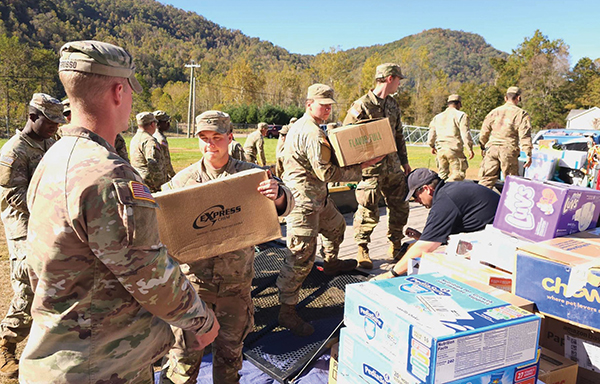
Soldiers assigned to the 2nd Battalion, 502nd Infantry Regiment unload
a trailer of supplies at a local community relief center in
Brunsville, NC, on 10 October 2024. (Photo by MSG Anthony Hewitt)
Throughout the JOA, ISVs proved essential to maintaining the operational
pace required to assist the local communities in their recovery. The
simplicity of the ISV platform allowed TF Falcon to mass Soldiers and
individual equipment at any given location in the JOA within two hours.
Despite the mobility and versatility of the ISV in the mountainous
environment, logistical resupply of forward elements was consistently
hampered by the capabilities of legacy vehicles. Due to what equipment
was on hand, TF Falcon relied heavily on HEMTT platform vehicles to
provide logistical support. These vehicles lacked the simplicity and
maneuverability of the ISV fleet and thus took significantly longer to
employ within the JOA. Consequently, HEMTT convoys took an average of
three to four hours to complete missions and required extensive route
reconnaissance to ensure adequate road space, structure, and vertical
clearance. These limitations inherent to the design and purpose of the
HEMTT platform created significant strain in exchange for the ability to
relocate bulk sustainment assets within the JOA.
The utilization of land use agreements and life support contracts to
rapidly stand-up multiple LSAs within the operational environment were
critical to TF Falcon’s success in the civil support mission set.
Contracting officer representatives (CORs) were essential in this
process, as their liaising between task force staff and local businesses
facilitated rapid awarding and fulfillment of contracts to support our
Soldiers in their mission set. By rapidly establishing multiple LSAs, TF
Falcon could conduct decentralized operations throughout the JOA, giving
commanders the freedom to operate from whichever location was closest to
the communities specified in their MATOs.
Integration of Public Affairs
Embedding a public affairs officer (PAO) from division for the duration
of this operation increased positive atmospherics for the battalion,
represented by a greater number of views, positive reactions, and
increased public awareness in the JOA. The PAO liaised with news
agencies and social media outlets, creating opportunities to spread
strategic messages on multiple platforms. This included coordinating and
executing video interviews with Senator Ted Budd, FOX News, and CBS.
Additionally, the PAO advocated for battalion photographs, videos, and
stories through division channels to ensure public affairs goals met the
commander’s intent. At daily commander’s update briefs, the PAO provided
updates by the numbers to ensure shared understanding of the reach of
public messaging.
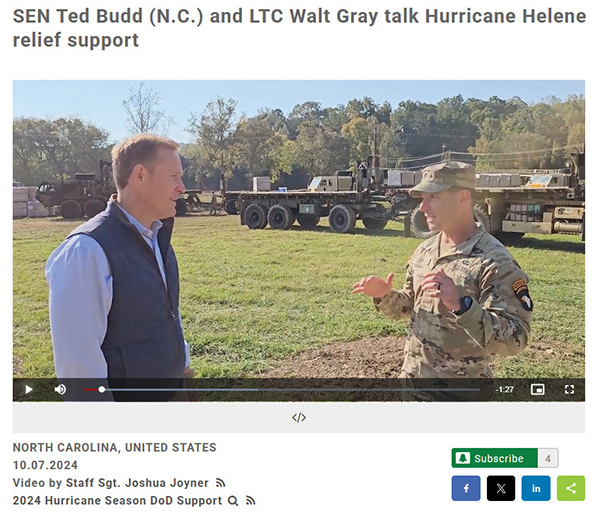
Figure 3 — Example Public Affairs Interview
In future operations, an embedded PAO could serve as liaison for
organizations beyond media. For example, morale organizations (USO,
Salvation Army, local donors) liaised with individual camp mayor cells
rather than a central battalion representative. With the PAO acting as
the interface for these and other groups, it would create a single point
of contact who regulates the relationships between battalion and the
civilian population.
Command and Control (C2) Architecture
We utilized a split command post to achieve better proximity to the
affected areas with the main command post located at LSA Windy Gap and
the alternate command post, which was co-located with our higher
headquarters, TF Castle, in Marion (50 miles apart). We aligned
companies to specific counties to spread the forces throughout the area
of operations. Throughout the operation, Bravo Company, completed MATOs
in Haywood County (primarily in and around Waynesville, NC) and even
established a more forward LSA at the county fairgrounds where Soldiers
slept and sustained themselves. Alpha Company, Charlie Company, and MFRC
completed MATOs and other operations in Buncombe, Madison, Yancey, and
Mitchell counties at various points in the operation but rested and
resupplied primarily at LSA Windy Gap.
Our battalion S-1 utilized a by-name personnel status report to
accurately track personnel strength in the JOA. Trip tickets and an
entrance/exit control point (ECP) to the LSAs provided sufficient
operational data to track movement of personnel and the humanitarian aid
operations. Using Microsoft Power BI to count, display, and sort all
this data, the S-1 promoted a shared understanding of TF Falcon’s
personnel strength with both the higher headquarters (forward and rear)
and within the task force.
TF Falcon used a distinct C2 configuration across our two command posts
(CPs). We were required to employ specific equipment, compounded by the
challenging mountainous terrain, which resulted in significant elevation
variations. Initially, our CPs established a foothold with limited
cellular capabilities but quickly transitioned to an in-place solution
using Starlink. Our reliance on Starlink for highspeed internet became
essential as frequency deconfliction between our systems and civilian
systems restricted the available waveform types.
The companies faced a unique set of challenges as they experienced
severe elevation changes in the mountainous terrain while utilizing our
new radios and capabilities. Although they had access to limited
waveforms similar to those of the CPs, the approved source for local
radio communication was frequency modulation (FM). However, FM
communications were largely ineffective due to the need for line of
sight (LOS), which was hindered by the topography. Consequently, the
companies relied heavily on cellular service and the Starlink systems of
local fire and police departments to maintain communication with the
CPs.
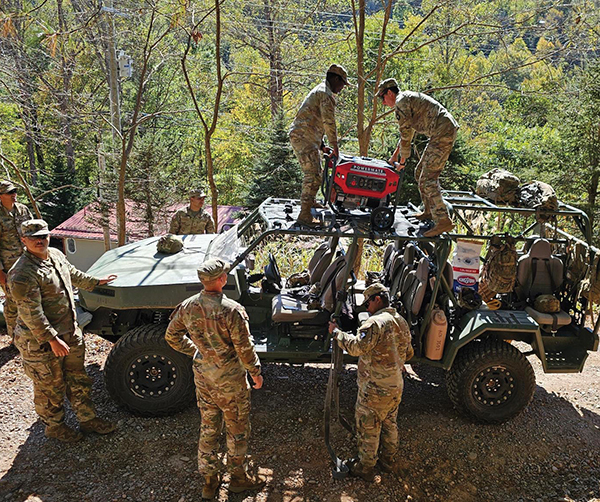
At left, Soldiers in 1st Platoon, Alpha Company, 2nd Battalion,
502nd Infantry Regiment, 2nd Mobile Brigade Combat Team, 101st
Airborne Division (Air Assault), remove debris so a local citizen
can get to her tractor in western North Carolina on 11 October 2024.
Above, Soldiers assigned to 2-502 IN deliver a generator to an
isolated citizen during Hurricane Helene relieve efforts in
Brunsville, NC, on 10 October 2024. (Photos by MSG Anthony Hewitt)
To enhance our humanitarian response efforts, a proactive approach to
frequency deconfliction and local unit support through spectrum
management would be beneficial. The Tactical Scalable Mobile (TSM)
network could have mitigated some of the challenges associated with
elevation and LOS issues encountered by the companies. Furthermore, in
non-tactical scenarios, satellite communications were pivotal to the
mission’s success. Starlink capabilities are essential both on and off
the battlefield, especially in environments lacking local communication
infrastructure.
Conclusion
Task Force Falcon deployed 537 Soldiers and 67 ISVs by large-scale,
long-range air movement with less than 18-hour notice in support of
humanitarian aid, utilizing the same TTPs that enabled success in
force-on-force training exercises during JRTC Rotation 24-10. The
equipment and capabilities that enable fast, effective, and controlled
operations for a mobile brigade combat team in a contested environment
can be effectively employed to provide support to civilian authorities
as well. TF Falcon’s ability to implement the tools and operating
procedures tailored to warfighting into a humanitarian aid mission
demonstrates the flexibility and dynamic strength of the MBCT.
Author
LTC Walter C. Gray II currently commands 2nd Battalion, 502nd Infantry
Regiment, 2nd Mobile Brigade Combat Team (MBCT), 101st Airborne
Division (Air Assault), at Fort Campbell, KY. He is a graduate of the
Infantry Officer Basic Course, Maneuver Captains Career Course,
Command and General Staff College, and School of Advanced Military
Studies. LTC Gray earned a bachelor’s degree in political science from
Kansas State University and a master’s of science in administration
from Central Michigan University.
MAJ Paul Bingham currently serves as the S-3 of 2-502 IN, 2/101 MBCT.
He is a graduate of the Infantry Basic Officer Leader Course, Maneuver
Captains Career Course, School of Advanced Military Studies, and
Command and General Staff College. MAJ Bingham earned a bachelor’s
degree in history from Tennessee University.
CPT Matt Kenny currently serves as the S-2 of 2-502 IN, 2/101 MBCT. He
is a graduate of the Infantry Basic Officer Leader Course and Military
Intelligence Captains Career Course. CPT Kenny earned a bachelor’s
degree in Hispanic studies and secondary education from Boston
College.